Over the last couple of months, I have published a series on LinkedIn titled “Did you know?“, which provides tips about some of the lesser-known MemoQ features that can improve your productivity. However, those posts have the tendency of getting buried in a sea of social media updates, so I’ve decided to re-compile them here for your convenience. Enjoy!
Quick Access Toolbar
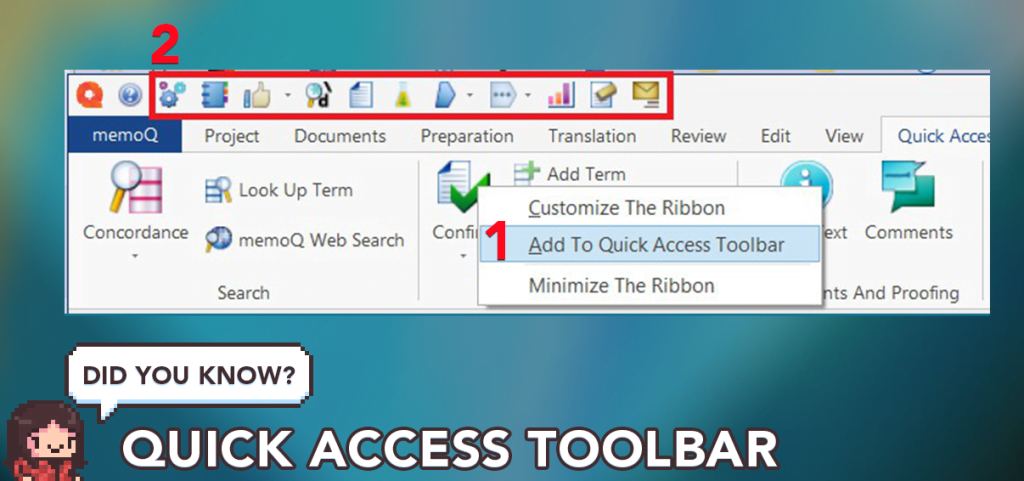
A MemoQ feature that we don’t talk often enough is the Quick Access ribbon – think of it as your own personal menu, that you can customize with all the functions you use on a regular basis. Here are some of my favorites:
- QA – A must-have for any file or project: never deliver without fixing QA issues or marking them as ignored.
- Regex editor – If your tags aren’t already filtered, the Regex editor allows you to apply existing filters or apply new ones.
- Jump to segment – When using filters, I often use this to jump back and forth between segments. Beats using the mouse to scroll!
- Tag filtering – Have you ever worked on projects where tags are literally walls of text? This allows you to quickly switch between long and short versions of tags for easier parsing.
- Tag commands – More tag options. Add, remove or edit them at will!
- Statistics – You know those pesky 500-word limits for App Store pages? Yeah, never open a 3rd party word counter again.
- Clear translations – Does your PM like to assign you files full of garbage patched matches? Get rid of them in one fell swoop!
- Deliver file – Self-explanatory 🙂
Do you use the Quick Access ribbon? Which functions did you add to it?
Centering Active Segments
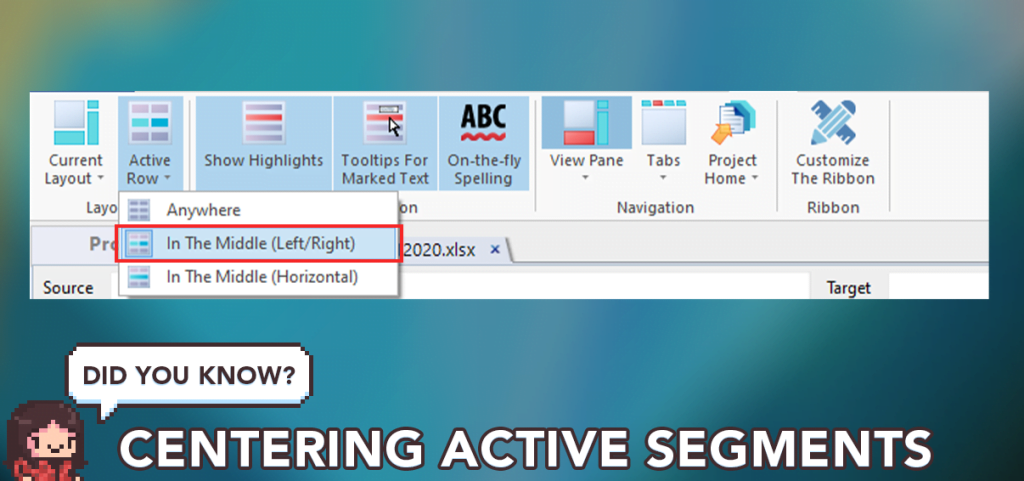
I’ve been looking for this #MemoQ function everywhere, so now that I found it, might as well share! Did you know that you can center the active segment to prevent endless scrolling back and forth? Simply go to View > Active Row > In The Middle (Left/Right) and your active segment will always be right in the center of your translation editor.
MemoQ Web Search

One of the MemoQ features I use on a daily basis is the Web Search tool: with one click, I can run dozens of different queries from different sources, both for my source and target languages, without having to open various browser tabs. Have you tried it yet? If not, here’s a quick rundown:
1. Download my custom EN/FR settings: https://lnkd.in/eHP-PSzE
2. Go to MemoQ options ➡️ Default Resources ➡️ Web search
3. Right-click ➡️ Import New
4. Select the MQRES file you downloaded
5. Click the checkbox if you want to add it as a default resource
6. In a translation project, highlight any word and press CTRL + F3 to display the search results!
Of course, you can customize those settings however you prefer, this is just for the purpose of the demo. This filter is configured for Wikipedia, Bing pictures, Expressio, Wikitionaire (FR) and Reverso (EN-FR).
Advanced Views
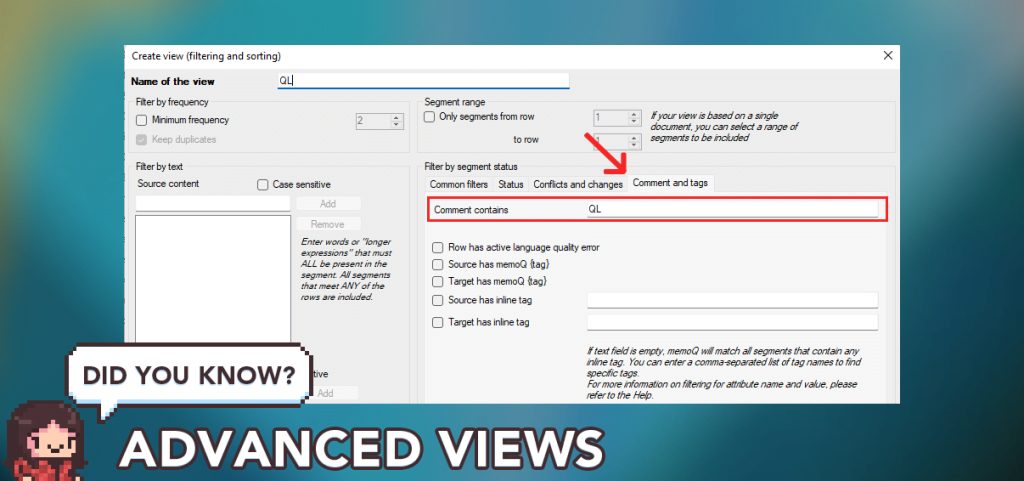
On MemoQ, when a file already has pre-imported comments and you add your own comments (or “highlights”) on top, they both show as “Comments” in the filter, regardless of type. Here’s how to isolate your own comments using the Advanced View feature:
1. When commenting, make sure to always use the same identifier (in my case it’s “QL”, or Query List).
2. Once you’re done, right-click the file and select Create View.
3. Give it a name and go to Advanced Options.
4. Open the “Comment and tags” tab, and in the “Comment contains” field, add your identifier.
And voilà, you’ll have a clear view of all the segments that need to be reviewed later on!
Removing Excel Inline Formatting
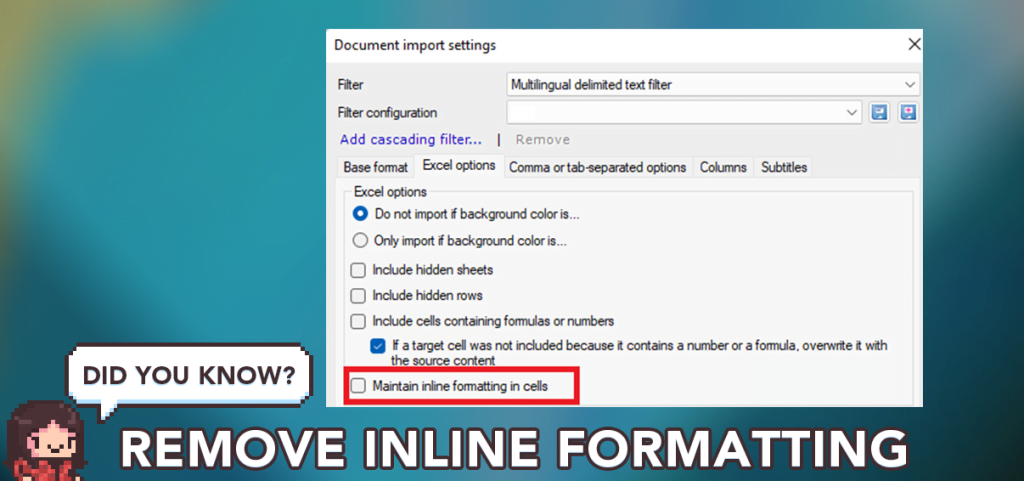
Have you ever had a client who just loves to send you source texts full of colors, highlights, and other RPR-type tags that are not required for the translation? If you import those Excel files with the default filter, chances are you’ll end up with this kind of tag soup:

Of course, you could go the long way around and delete the formatting in Excel before importing the file, but in my experience, it doesn’t get rid of all of them. Thankfully, MemoQ can handle that for you with this one simple trick!
To do so, follow those steps:
1. Select “Import with Options…” and pick the source file.
2. Select “Multilingual Delimited Text Filter”.
3. Go to the “Excel Options” tab (as shown in the picture above).
4. Untick the “Maintain inline formatting in cells” box.
This will remove any and all kinds of Excel formatting while preserving it in the source column! You can also learn more about different types of tags here: Link
A big thanks to Jessica Amoruso for her insights on the topic!
Quick Project Switcher

If you work on many projects throughout the day, whether locally or on MemoQ servers, you’ll likely have to switch back and forth between them regularly. This can sometimes be inconvenient if your translation dashboard is filled with projects that you are not actively working with.
Thankfully, you can open recent projects and even pin them simply by right-clicking the MemoQ icon in your Windows taskbar! To pin a project, simply hover on the title and click on the pin icon. The best part? Using this feature allows you to switch immediately between projects without going through the dashboard!
Statistics Tool
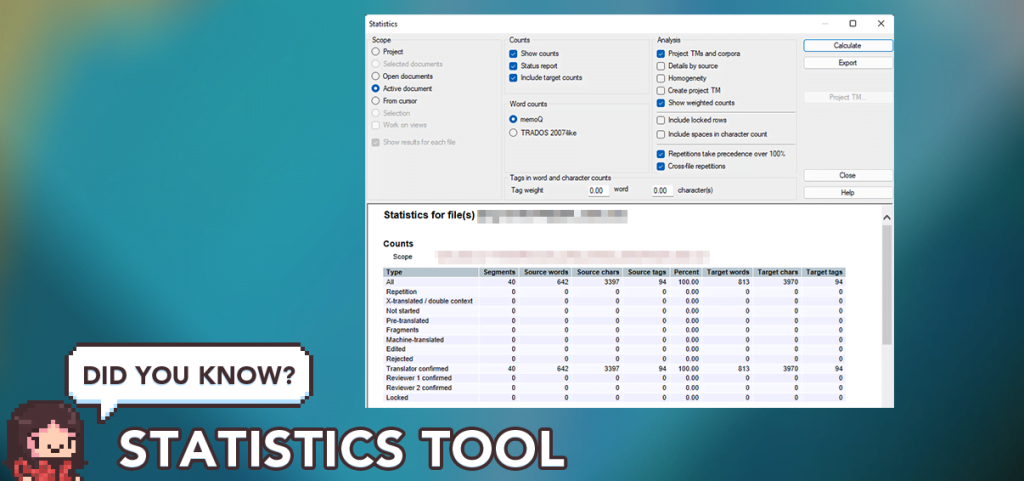
Translation is a number game, and the Statistics tool is all about raw numbers. This allows you to know exactly how many words are included in a project/document/view, how many of those are Fuzzy matches, as well as a ton of other options that give you a precise idea of what your files are made of.
I use the Statistics tool for my translation quotes (you can generate an XLS export by right-clicking the results window) but also to calculate some character limits: if you’ve ever had to translate a Google Play store description, you’ll know there are strict character limits across the entire description (usually 500 per entry), but they aren’t restricted to a single segment. By selecting the relevant segments, you’ll be able to have a clear idea of if your translation will fit.
You can access the Statistics tool in your Project Home, or in the Documents menu if you have a file/view open.
Appearance Tweaks
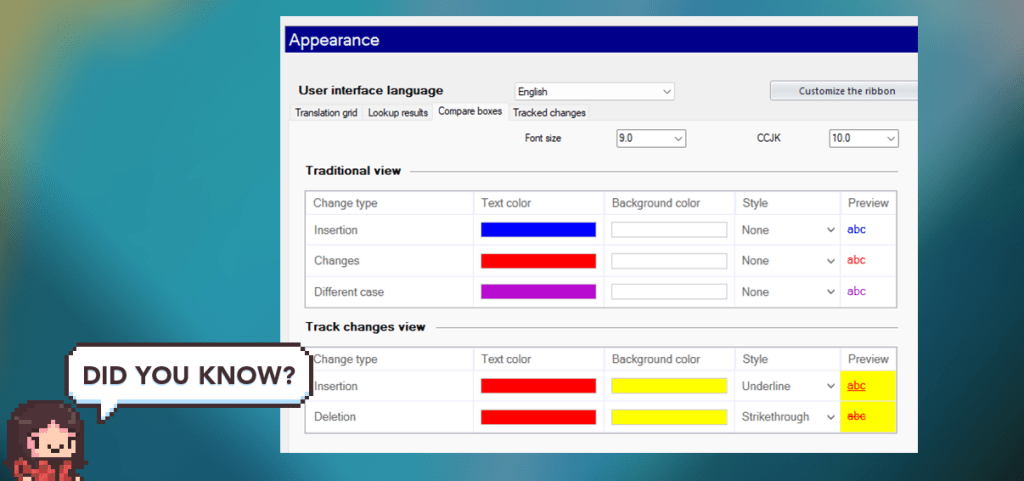
Considering how much time translators spend in front of their CAT tools, maximizing visual comfort should be one of your priorities. In order to maximize efficiency, I usually recommend using a font that is easy on the eyes (Google Noto Sans is my personal favorite) and adapting the font size to your eyesight and display resolution.
Additionally, I highly recommend adding a bright background color to the “Track changes view” as shown above, in order to display changes more prominently when the changes are minor (thanks for the tip, Thomas!):
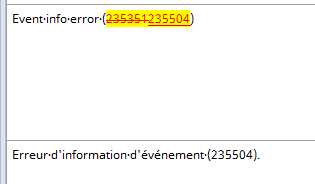
Don’t hesitate to fiddle with the Appearance settings (Found in Main menu > Settings > Appearance) to find what’s best for you! If you don’t like the results, you can always revert changes with “Reset these settings”.
Using Regex for QA
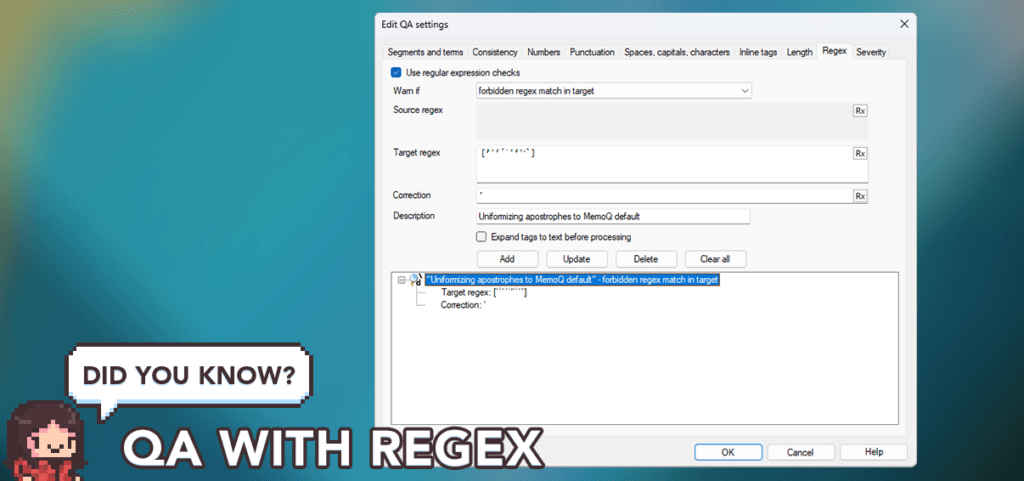
Most advanced MemoQ users are aware of the Regex filters, which can be used for a variety of things: from automatically tagging out untranslatable content to filtering new imports and more. But did you know that you can also use it to make sure unwanted characters don’t show up in QA?
As shown in the example above, there are over 10 different types of apostrophes in French alone, and not all CAT tools use the same one by default (hell, even MemoQ Web and MemoQ client aren’t consistent). Since this character can be a bit difficult to distinguish visually, I’ve created a QA filter that automatically warns me when non-standard apostrophes are included in the target field using the following Regex pattern:
[’ʾ′'ˊˈꞌ‘ʿ‵ˋ]
Of course, this is not limited to apostrophes. You can add all kinds of characters using the same method (I’m using it to filter out Asian punctuation signs such as 【 】, 《…》or ※).
Filtering Through Tags
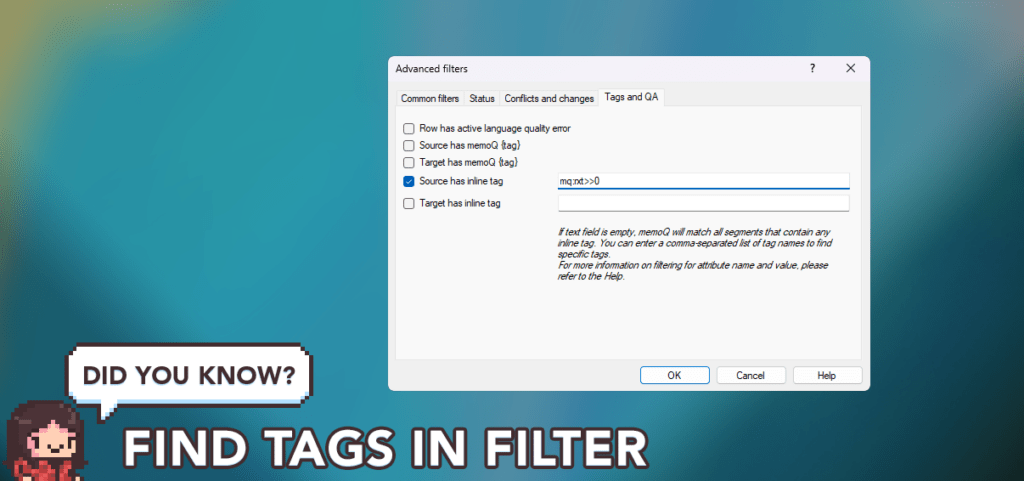
MemoQ offers a wide array of filters and sorting options, which can be a lifesaver when working on large, unorganized files. By default, however, you can’t filter tag content through the basic Search feature – you need to use the Advanced filters option. And even then, finding what you’re looking for is not as easy as it seems.
Since every type of tag is its own distinct entity, they needs to be filtered accordingly. Thankfully, 99% of the MemoQ tags generated through the Regex tagger can be found with the following:
mq:rxt>>0In this example, simply replace “0” with the content you’re looking for in the source, target or both, and you’re off to the races!
With Advanced Search And Replace, you can also use Regex to look up tags based on various criteria :
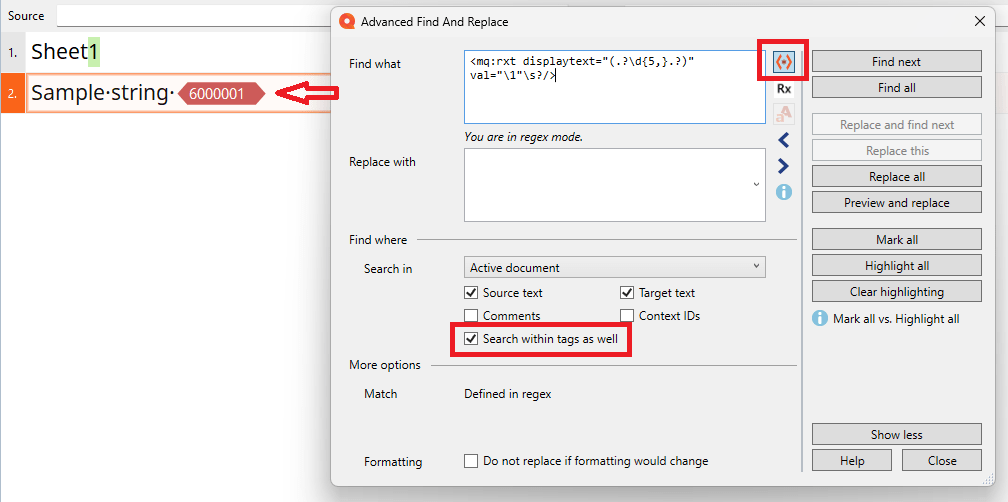
The example above looks for any tag containing 5 or more digits:
<mq:rxt displaytext="(.*?\d{5,}.*?)" val="\1"\s?/>
If you’d like to learn more about tags and their properties, I highly recommend you check the related page on MemoQ’s documentation.
Shoutout to Valeriy Timchenko for these handy tips!
This page will be updated periodically, but if you’d like to get more tips as soon as they’re published, feel free to add me on LinkedIn – I’m always happy to connect with L10N students & professionals!






